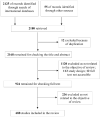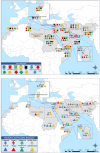Emerging and Re-emerging Infectious Diseases in the WHO Eastern Mediterranean Region, 2001-2018
- PMID: 33904695
- PMCID: PMC9808364
- DOI: 10.34172/ijhpm.2021.13
Emerging and Re-emerging Infectious Diseases in the WHO Eastern Mediterranean Region, 2001-2018
Abstract
Background: Countries in the World Health Organization (WHO) Eastern Mediterranean Region (EMR) are predisposed to highly contagious, severe and fatal, emerging infectious diseases (EIDs), and re-emerging infectious diseases (RIDs). This paper reviews the epidemiological situation of EIDs and RIDs of global concern in the EMR between 2001 and 2018.
Methods: To do a narrative review, a complete list of studies in the field was we prepared following a systematic search approach. Studies that were purposively reviewed were identified to summarize the epidemiological situation of each targeted disease. A comprehensive search of all published studies on EIDs and RIDs between 2001 and 2018 was carried out through search engines including Medline, Web of Science, Scopus, Google Scholar, and ScienceDirect.
Results: Leishmaniasis, hepatitis A virus (HAV) and hepatitis E virus (HEV) are reported from all countries in the region. Chikungunya, Crimean Congo hemorrhagic fever (CCHF), dengue fever, and H5N1 have been increasing in number, frequency, and expanding in their geographic distribution. Middle East respiratory syndrome (MERS), which was reported in this region in 2012 is still a public health concern. There are challenges to control cholera, diphtheria, leishmaniasis, measles, and poliomyelitis in some of the countries. Moreover, Alkhurma hemorrhagic fever (AHF), and Rift Valley fever (RVF) are limited to some countries in the region. Also, there is little information about the real situation of the plague, Q fever, and tularemia.
Conclusion: EIDs and RIDs are prevalent in most countries in the region and could further spread within the region. It is crucial to improve regional capacities and capabilities in preventing and responding to disease outbreaks with adequate resources and expertise.
Keywords: CCHF; Eastern Mediterranean Region; Emerging Infectious Diseases; MERS-CoV; Neglected Tropical Diseases; Zoonosis.
© 2022 The Author(s); Published by Kerman University of Medical Sciences This is an open-access article distributed under the terms of the Creative Commons Attribution License (http://creativecommons.org/licenses/by/4.0), which permits unrestricted use, distribution, and reproduction in any medium, provided the original work is properly cited.
References
-
- World Health Organization (WHO). The Work of WHO in the Eastern Mediterranean Region: Annual Report of the Regional Director 2014. World Health Organization. Regional Office for the Eastern Mediterranean; 2015.
-
- The World Bank. Population, Total. The World Bank; 2018. https://data.worldbank.org/indicator/SP.POP.TOTL. Accessed February 24, 2018.
Publication types
MeSH terms
Grants and funding
LinkOut - more resources
Full Text Sources
Medical


